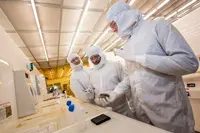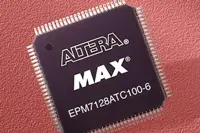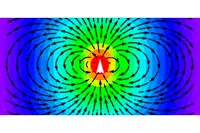Electronics News
Archive : 10 April 2015 год
 Large area graphene is able to preserve electron spin over an extended period, and communicate it over greater distances than had previously been known, according to researchers based at Chalmers University of Technology. The findings, published in Nature Communications, have opened the door for the development of spintronics, with an aim to manufacturing faster and more energy-efficient memory and processors in computers.
Large area graphene is able to preserve electron spin over an extended period, and communicate it over greater distances than had previously been known, according to researchers based at Chalmers University of Technology. The findings, published in Nature Communications, have opened the door for the development of spintronics, with an aim to manufacturing faster and more energy-efficient memory and processors in computers.
Based on the quantum state of the electrons, spintronics is already being used in advanced hard drives for data storage and magnetic random accesses memory.
Spin as a property in electrons is very short-lived and fragile, but could make processors significantly faster and less energy consuming than they are today.
The research suggests that graphene is a promising candidate for extending the use of spintronics in the electronics industry as the thin carbon film is not only an excellent electrical conductor, but also in theory has the rare ability to maintain the electrons with the spin intact.
"In future spin-based components, it is expected that the electrons must be able to travel several tens of micrometers with their spins kept aligned. Metals, such as aluminium or copper, do not have the capacity to handle this. Graphene appears to be the only possible material at the moment," said Saroj Dash, who leads the research group at Chalmers University of Technology.
Graphene is currently produced commercially by only a few companies however, high-quality graphene can only be obtained in very small pieces. Larger pieces are often of poor quality or have other drawbacks from the perspective of the electronics industry.
Researchers at Chalmers have conducted their experiments using CVD graphene, which is produced through chemical vapour deposition. While the method gives the graphene a lot of wrinkles, roughness and other defects there are good prospects for the production of large area graphene on an industrial scale.
The CVD graphene can also be easily removed from the copper foil on which it grows and is lifted onto a silicon wafer, which is the semiconductor industry's standard material and while the material is still poor, the research group can now show parameters of spin that are up to six times higher than those previously reported for CVD graphene on a similar substrate.
"Our measurements show that the spin signal is preserved in graphene channels that are up to 16 micrometers long. The duration over which the spins stay aligned has been measured to be over a nanosecond," says Chalmers researcher Venkata Kamalakar . "This is promising because it suggests that the spin parameters can be further improved as we develop the method of manufacturing."
"We believe that these results will attract a lot of attention in the research community and put graphene on the map for applications in spintronic components," says Saroj Dash, who leads the research group at Chalmers University of Technology.
Author
Neil Tyler
Source: www.newelectronics.co.uk
 Following an agreement with Altera, Rochester Electronics will be able to provide a long term supply pipeline of the company's mature FPGAs and CPLDs.
Following an agreement with Altera, Rochester Electronics will be able to provide a long term supply pipeline of the company's mature FPGAs and CPLDs.
Following an agreement with Altera, Rochester Electronics will be able to provide a long term supply pipeline of the company's mature FPGAs and CPLDs.
Chris Gerrish, Rochester's president, said: "We are pleased to expand our partnership with Altera to include selective members of its mature parts. By entering into this agreement, we are able to enrich our product catalogue and further support our customers' supply requirements."
Devices covered by the agreement include select MAX 7000 CPLDs and FLEX, APEX and Stratix GX FPGAs. According to Rochester, these devices are used in applications such as military/aerospace, transportation, medical, industrial and communications, all of which need extended availability of components. Rochester says users will have continued access to a secure and reliable source of these FPGAs and CPLDs and adds that it will support orders for small quantities.
Author
Graham Pitcher
Source: www.newelectronics.co.uk
 Researchers at the University of Cambridge say they have unravelled one of the mysteries of electromagnetism and add their work could allow the creation of antennas small enough to be integrated into a chip.
Researchers at the University of Cambridge say they have unravelled one of the mysteries of electromagnetism and add their work could allow the creation of antennas small enough to be integrated into a chip.
"Antennas are one of the limiting factors when trying to make smaller and smaller systems, since below a certain size, the losses become too great," said Professor Gehan Amaratunga of Cambridge's Department of Engineering, who led the research.
The team has proposed that electromagnetic waves are not only generated from the acceleration of electrons, but also from a phenomenon known as symmetry breaking. In addition to the implications for wireless communications, the discovery could help identify the points where theories of classical electromagnetism and quantum mechanics overlap.
According to the researchers, certain physical variables associated with radiation of energy are not well understood. While Maxwell determined that electromagnetic radiation is generated by accelerating electrons, this theory is said to become problematic when dealing with radio wave emission from a dielectric solid – already used for antennas in mobile phones, for example.
"In dielectric aerials, the medium has high permittivity, meaning the velocity of the radio wave decreases as it enters the medium," said researcher Dr Dhiraj Sinha. "What hasn't been known is how the dielectric medium results in emission of electromagnetic waves. This mystery has puzzled scientists and engineers for more than 60 years."
Working with the National Physical Laboratory and Cambridge based Antenova, the team used thin films of piezoelectric materials and found that, at a certain frequency, these materials become not only efficient resonators, but also efficient radiators. The researchers believe this is due to symmetry breaking of the electric field associated with the electron acceleration.
"If you want to use these materials to transmit energy, you have to break the symmetry, as well as have accelerating electrons – this is the missing piece of the puzzle of electromagnetic theory," said Prof Amaratunga. "I'm not suggesting we've come up with some grand unified theory, but these results will aid understanding of how electromagnetism and quantum mechanics cross over and join up. It opens up a whole set of possibilities to explore."
Author
Graham Pitcher
Source: www.newelectronics.co.uk

